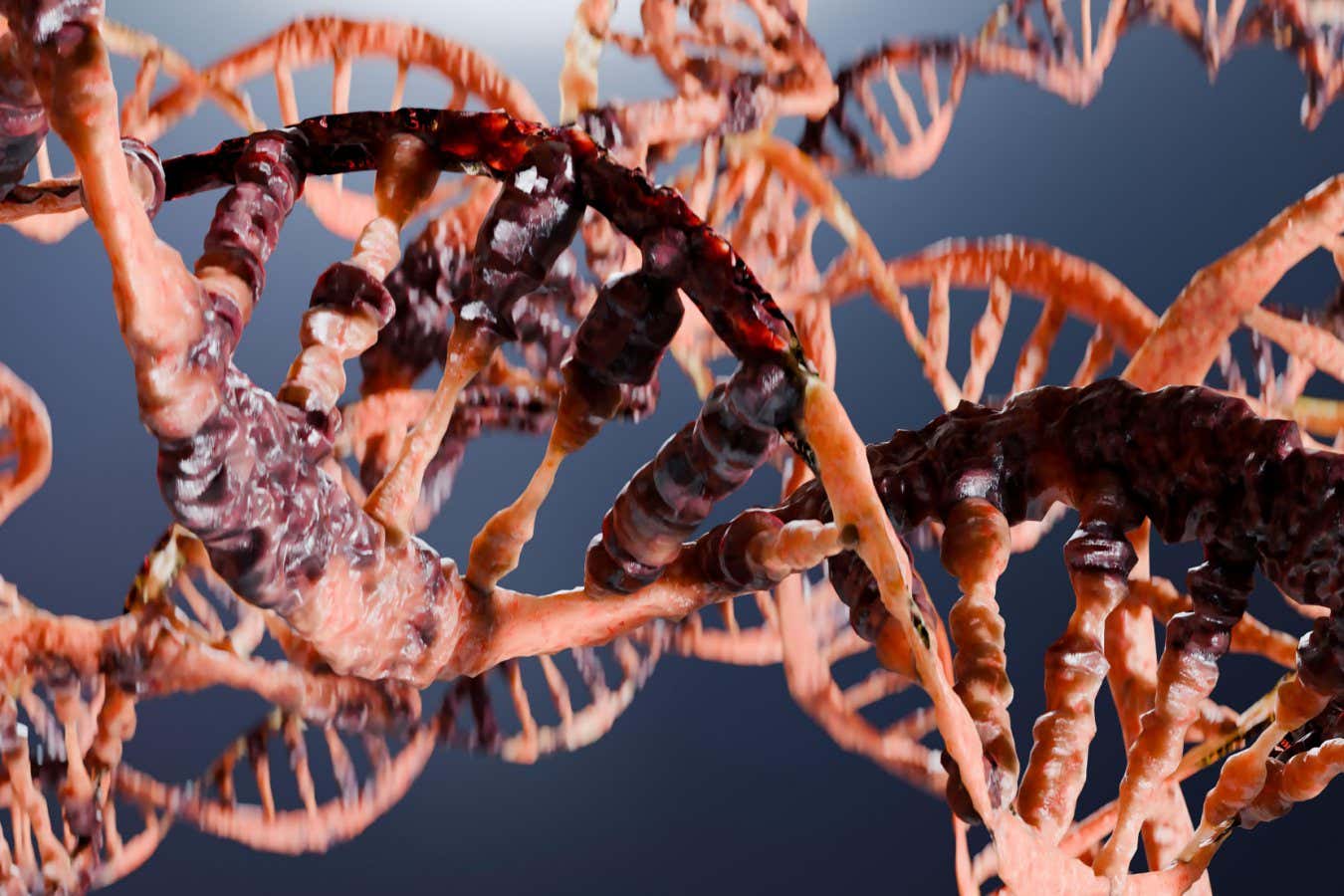
One explanation for why we age is the accumulation of mutations in the DNA of cells
Mohammed Elamine ALIOUI / Alamy
A clump of proteins seems to be in charge of the level of DNA repair that takes place in our bodies, determining how fast mutations accumulate in our cells over a lifetime – and might thus affect our rate of ageing and our lifespan.
“It’s a very reliable predictor of your lifespan, within humans and within other animals,” says Trey Ideker at the University of California, San Diego. His team hopes to find drugs that boost lifespan by improving DNA repair levels.
Other researchers say the evidence that this protein complex – a group of two or more proteins that physically interact to perform a specific biological function – affects mutation rates is convincing, but that more work is needed to confirm the link with ageing and longevity.
As to why we age, one explanation is that it is a result of the accumulation of mutations in the DNA of cells. As these build up, more and more cellular machinery becomes defective, leading to cascading problems.
Cells do have the equivalent of repair crews that go out and fix broken DNA, but there aren’t always enough of them – that is, the level of DNA repair varies, which is probably mostly due to genetics.
Now, Ideker’s team has assembled several lines of evidence that suggest a protein complex called DREAM is a master regulator that determines this level of repair – a kind of boss for the repair crews. Each complex – which can exist in numerous, identical copies in every cell – is formed by the joining together of several different proteins, with the acronym DREAM referring to the names of the components.
DREAM was initially thought to control cell division, but it turns out it also switches off hundreds of genes involved in DNA repair, including the BRCA2 gene that raises the risk of breast cancer when mutated.
Ideker’s team first developed a measure of DREAM activity by looking at more than 300 genes it controls, with lower gene activity meaning higher DREAM activity. “What this study is trying to show beyond a shadow of a doubt is that high DREAM [activity] is bad for ageing and longevity, and low DREAM is good for longevity,” he says.
Using data from studies by other groups of more than 100,000 mouse cells from various tissues, the researchers then showed that cells with higher DREAM activity have more mutations. Next, they analysed data from 92 mammal species, finding a strong link between low DREAM activity and longer maximum lifespan.
In another part of their experiment, the researchers analysed data from studies of the cells of 90 people, including 80 with Alzheimer’s disease, finding a link between DREAM activity and the risk of the condition.
They also genetically engineered mice to lack DREAM. This was very difficult – not only does each component protein have its own role, DREAM as a whole has an important function in cell division in early development, meaning mice that lack it don’t survive.
To get around this, the team knocked out DREAM when the mice were 8 weeks old, using a genetic system triggered by a drug. The knockout mice had fewer mutations than unmodified mice after dying of old age – for instance, they had 20 per cent fewer deletions and insertions in their brain cells. The knockout mice didn’t live any longer, but Ideker says this is to do with the way they were modified. “It does not show any significant lengthening of longevity, but the experimental design was just wrong to look at that,” he says. “We now need to do the experiment correctly, where we can associate that with extension of lifespan.”
Despite this, Ideker thinks the combined evidence points to a clear picture. “What our results show is that DREAM is a key player in ageing, and certainly in the accumulation of lifetime mutation,” he says.
“These are new and important findings,” says João Pedro de Magalhães at the University of Birmingham in the UK. “Their mouse data shows causality between DREAM and mutation levels.” But the researchers haven’t demonstrated a causal link with ageing, he says. “To do so, they would have to show that mice with lower levels of mutations live longer, which nobody has done so far.”
This is why the idea that the accumulation of mutations is a key factor in ageing remains to be established. Proponents of the idea, such as Ideker, point out that conditions like progeria, where people age prematurely, involve a lack of DNA repair. Others, including de Magalhães, point to a lack of evidence that mutation accumulation is a factor in normal ageing, apart from increasing the risk of cancer.
Even if the DREAM complex does play a causal role in ageing, its multiple functions will make it tricky to develop treatments. “It may be that complete DREAM loss-of-function, like we did, is too extreme,” says team member Zane Koch, also at UCSD. “Partial DREAM inhibition may be the goldilocks zone where lifespan extension can be seen.”
Topics:
Source link : https://www.newscientist.com/article/2497492-how-fast-you-age-may-be-controlled-by-a-dna-repair-boss-in-your-cells/?utm_campaign=RSS%7CNSNS&utm_source=NSNS&utm_medium=RSS&utm_content=home
Author :
Publish date : 2025-09-26 11:00:00
Copyright for syndicated content belongs to the linked Source.